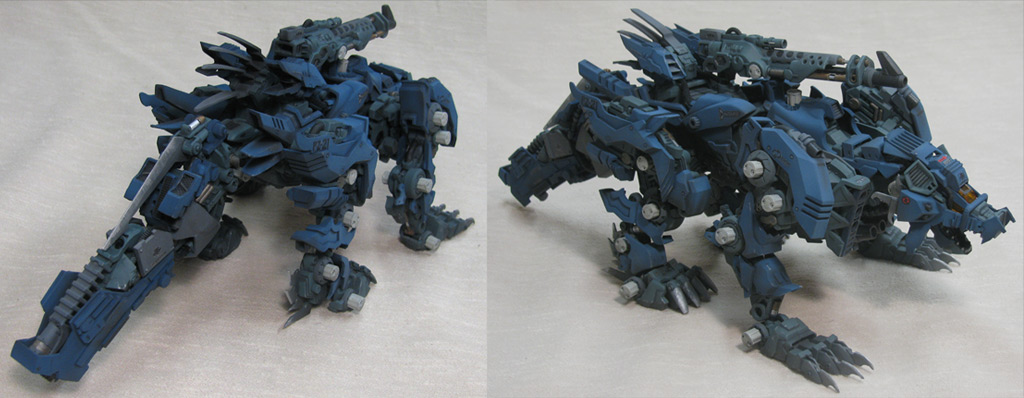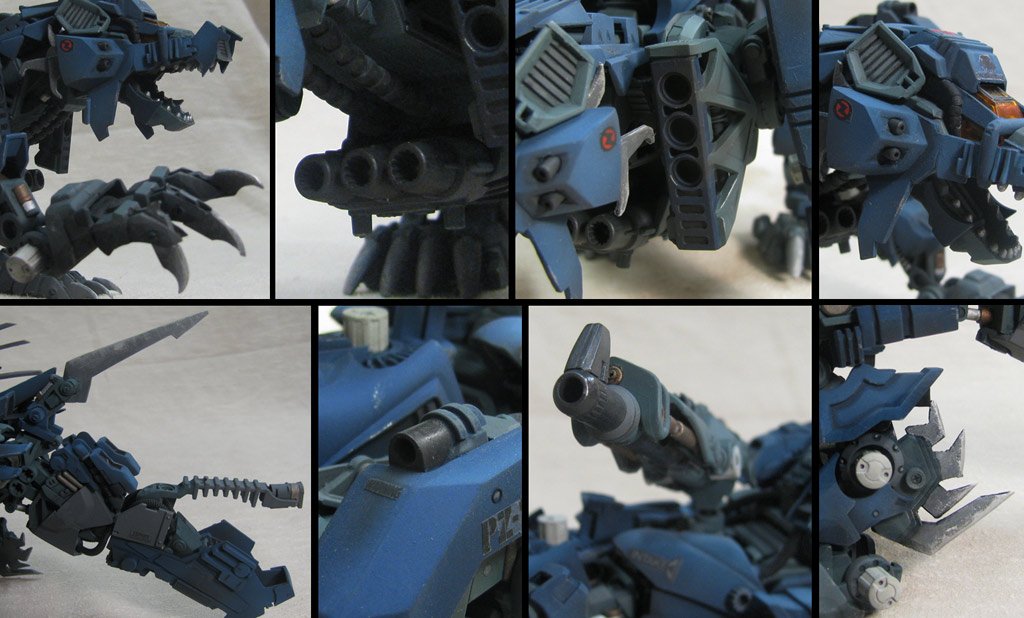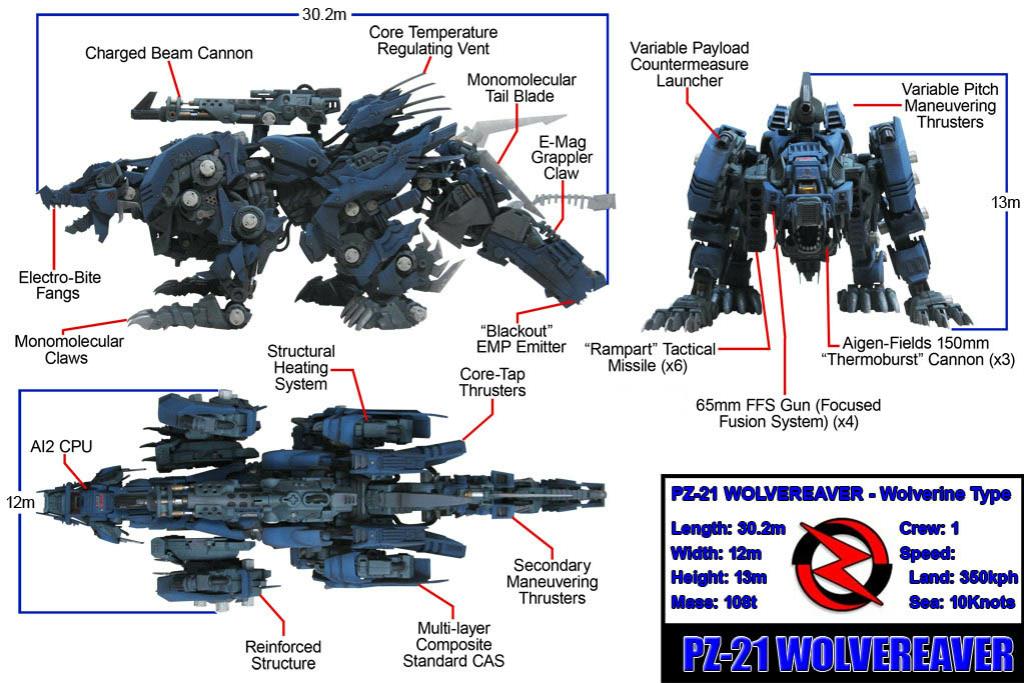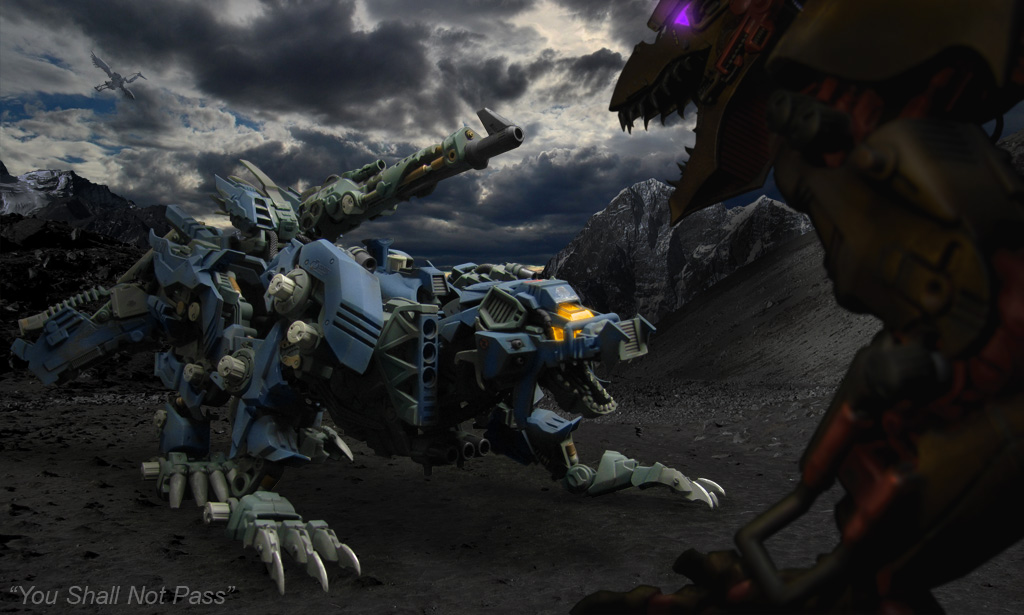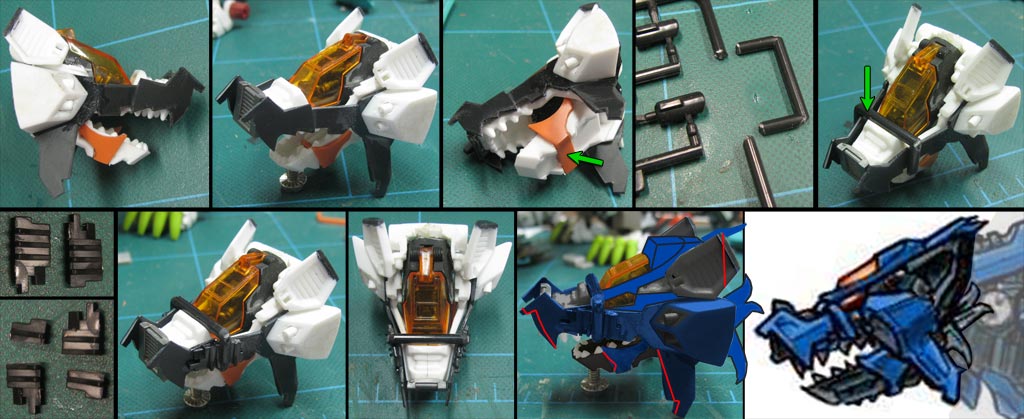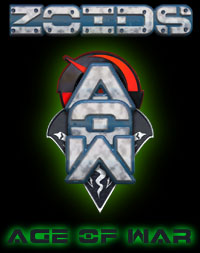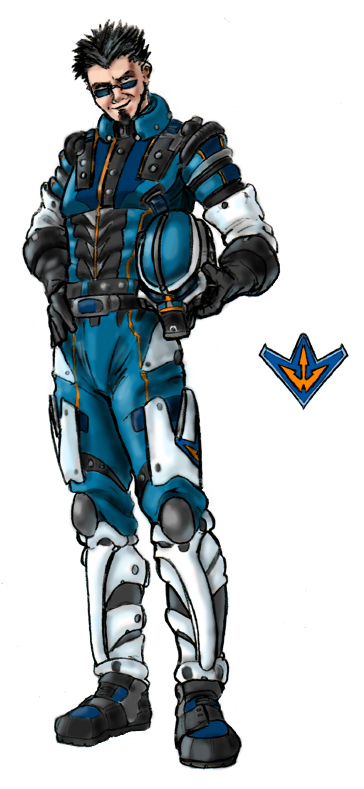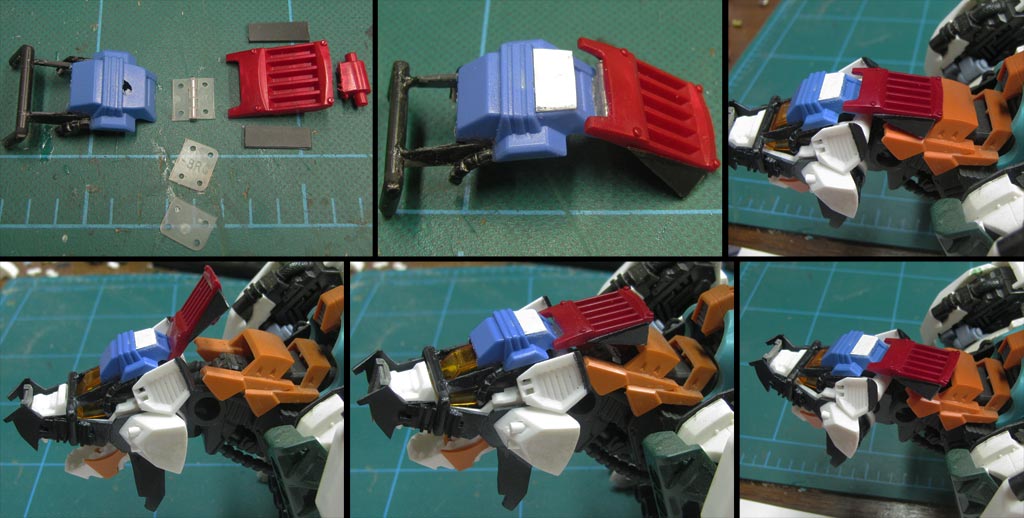RBOZ-030 PALADIN - 2007 Phenotype Contest Entry
This is truly a monster of a page; perhaps you should get some coffee...
WOLVEREAVER
Chassis: Wolverine
Power Plant: RPZ-202-KV5 (Royal Power Zoid - Quadruped Class 2 - Konig Variant 5)
Primary Mission: Extreme Environment Assault Platform
Secondary Mission: Fire Support
Crew: 1 (minimum rank requirement: Captain)
Statistics
Length: 30.2 meters
Width: 12 meters
Height: 13 meters
Mass: 108 tons
Performance
Land: 350 KPH
Sea: 10 Knots
ARMAMENT
Technological advancements abound in the Wolvereaver platform, and those advancements readily apply to weapons. First are the retractable monomolecular claws. Meaning one molecule thick at the sharpest point, which is capable of cutting virtually anything. The standard armor is then rounded out with a back-mounted beam cannon, shoulder missile pods and a electro-magnetic pulse gun (EMP) in the tail.
CBC (Charged Beam Cannon) – dorsal mounted, 360º arc, 80º inclination
The premise of the combination of the Wolvereaver’s chassis and the back mounted CBC was to create a Zoid with excellent speed and agility that was capable of effective close-in combat while delivering heavy damage at range through any arc. The CBC is a variable capacity weapon that can be used to snipe soft targets up to 10 kilometers distant or rip through a 200-ton Zoid up to a kilometer away. With a heavy reliance on capacitors and batteries, the CBC can fire very rapidly for a gun of its class, and it can do so in any direction during virtually any of the Wolverreaver’s activities.
“Rampart” Tactical Missile (x6) – shoulder mounted, forward arc, fixed
Each shoulder supports three missile tubes loaded with the Rampart tactical missile. This weapon has a range up to 50 kilometers with a bunker/armor busting warhead designed to penetrate dense ground and reinforced walls, then detonate within the structure. Against heavy Zoids it has proven to be less accurate than other missiles but provides a “one hit one kill” solution. If used against light recon units the missile may pass completely through the target before detonating deep in the ground on the far side.
“Blackout” EMP Emitter – tail mounted, 60º rear arc, 45º inclination
Appearing as a cylindrical canon system, this weapon sends a focused electromagnetic pulse into a target or a narrow area. When used against a single target, the pulse can knock out electrical systems and detonate batteries and charged systems up to 6 kilometers away. In its broader mode the Blackout interferes with electrical flow, can short out weaker components, and do so against dozens of opponents in a sweeping area up to 2 kilometers away.
Monomolecular Claws (x6) – forelimb mounted, forward arc, integrated construction
The Wolverreaver was primarily designed to rip through enemies in melee combat as opposed to bristling with myriad ranged weapon systems. The monomolecular claws can cut through virtually any material with brutal efficiency. ZOITEC decided upon the hardened monomolecular design rather than laser-edged blades in order to conserve power to allow CPC use during close combat.
Electro-Bite Fangs – head mounted, integrated construction
While the jaws of the Wolvereaver can cause considerable damage in their own right, the fangs are core-tapped and equipped with hyper-conducting blades that allow a massive surge of power during a bite. Units struck with this attack tend to function similarly as a large man to a tazer.
E-Mag Grappler Claw – tail mounted, 60º rear arc, 45º inclination
Built within the tail of the Wolveriever is another melee weapon with multiple abilities. The E-Mag claw allows the Zoid to grasp targets in the rear arc with crushing force. By tapping into the same core-tap architecture that empowers the Electro-Bite Fangs, the claw can convert its magnetic voltage to a charring surge of raw power. Further, the EMP Emitter on the claw tip can send a local pulse to incapacitate the victim, rendering it crushed, shocked, and powerless. Finally, the tail is strong and prehensile enough to throw most lighter Zoids several hundred meters after the attack.
65mm FFS Gun (x4) – head mounted, 60º rear arc, 45º inclination
The production model of the Wolvereaver features larger armored pods on its jowls, each housing a pair of FFS (Focused Fusion System) guns. These are core-tap weapons that convert the Zoid’s power into exceptionally hot energy beam that can slice through most solid materials like a plasma torch through tin. Though each 65mm gun has a very limited range of 2 kilometers due to rapid temperature loss, each pod may fire the pair of guns to double that range for very short bursts… before the intense heat damages the FFS weapons themselves. All four guns can cause damage to an enemy up to 5 kilometers away, but up close can simply slice a smaller Zoid in half.
Aigen-Fields 150mm Thermoburst Cannon (x3) – torso mounted, forward fixed, integrated construction
Mounted into the chest of the Wolvereaver are a trio of cannons that launch encapsulated plasma into a target much like a solid projectile weapon. The guns have an effective range of 5 kilometers, where the plasma field loses cohesion and releases the liquefied energy at some 3,000° Kelvin. While hot enough to melt a Zoid to slag. The nature of the round does not offer prolonged exposure to cause serious damage, but it is enough to vaporize wire, gaskets, canopies, and other “soft” materials. Each cannon requires in excess of two minutes to cool and charge the next round, influencing most pilots to cycle between guns rather then fire a multi-round burst.
Monomolecular Tail Blade – tail mounted, 180º rear arc, 90º inclination
Using the same technology as the extending claws, the tail blade is 4 meters of armor slicing doom. The weapon can be snapped about like a sword and is equipped with reactionary sensors the avoid any contact with the Wolvereaver in heated battle. The blade has a secondary utilitarian function as well; it can lock into the rear segment of the tail as a structural support and greatly increase the lifting strength of the tail when using its E-Mag Grappler Claw.
HISTORY
After the discovery of two of the three mysterious Tiger cores, the race between ZOITEC and Zi-ARMS, as the ultimate Zoid producing company, heated up. Although there was peace between the Republic and the Empire at the time, there was a race for higher technology and the search for the third tiger core. After ZOITEC’s completion of Whitz Wolf and Savinga to counter Zi-Arms development of Death Raser and Parablade, (and later Rayse Tiger for Brastle Tiger), ZOITEC spies learn that the next new Zoid developed by Zi-ARMS incorporated experimental technology never used for a Zoid before. In response, ZOITEC created a new revolutionary Zoid of their own; one designed to have the speed and maneuverability of the legendary Liger Zero and the power of a charging Dibison.
AI-2 PROFILE
Wolvereavers were one of the test platforms for AI-2 technology with some of the first reactionary impulse programming in a Zoid CPU. The current model has been updated with the complete AI-2 suite, resulting in a “quietly aggressive” Zoid that tends to value separation from other units but is capable of extremely rapid and violent infighting. Pilots find it is better to influence the Wolvereaver than to control it, but when it comes to doing combat it is best to let the machine take over; the pilot basically relegates himself to the role of gunner and seeks opportunities as they present themselves.
SUMMARY
The Republic bought up most of the Wolvereavers, including the first one. This Wolvereaver was thought to have the most fighting potential, and the Republican Army, for a hefty price, quickly acquired all it could. All of the Republic’s Wolvereaver units were extremely successful in their day, but the modern version of fully AI-2 integrated units are the best of the line, serving the Kingdom of Helic with distinction. The Zoids are expensive to produce and are employed in high risk areas, which has limited their production despite their excellent track record.
CONCEPT
The Wolvereaver is unlike any other build I have attempted because, unlike all the rest, the concept is not mine. The design isn’t mine. I did not choose the animal, the scale, the mission, or the features. This is my first ever commissioned project, and it wasn’t a matter of someone paying to make him a Zoid… it was a client hiring me to make THIS Zoid.
THE PLAN
I was provided not just with some sketches; I was provided with professionally drawn blueprints to this Zoid! No pressure. I was given some license to create but there were certain features that would be a requirement: 1) the extendible claws, 2) the overall form of a wolverine, 3) a full CAS. I could use whatever parts I needed to and omit some details (it is one thing to draw a set of hydraulics for a limb, quite another to physically build them without fabrication equipment). Still, even with some license, it was going to be a task and a half to well represent someone else’s vision.
WOLF TO WOLVERINE
The plan was easy; just like Eradicator and Siobhan, I would sub-divide the body for flexibility and remove the cams in favor of ball-and-socket-joints. Such a simple plan....
BACK TO BASICS
My answer to the jointing was, again, made possible through Shevon... who also had gifted me the perfect Bionicle set! Thanks, love! Here you can see the body shells reunited with the new joints set in place (not attached yet; this was a trial run). I had looked at using my heavy Struxx joints but they were just too large, and Bloxx or Asoblock joints were simply too small. The long support pegs would have to go, however, and perhaps the stubs could still be useful as details.
COMBINED EFFORTS
Construction of the left foreleg. Pic #1 shows a shaped Bionicle joint screwed into the HMM Liger chest piece; I did this for sheer strength. The nature of the pieces now gives each shoulder two ball-and-socket joints and three hinge joints for really impressive flexibility. #2 shows the modifications required to fit a Hasbro Konig Wolf foreleg into an HMM Liger Zero shoulder, and #3 shows the "keyhole" cut I used to affix the HMM LZ ankle joint. #4 was my first attempt at using the HMM foot, but it simply wouldn't transition well, so #5 is the direction I went, using the HMM joint to join the Konig shin and foot. Finally, you see in #6 how they all work together: HMM shoulder > Konig shin > HMM joint > Konig foot > Dark Spiner's toes.
CAPABILITIES - (continued)
In order to function in environments of extreme cold the Wolvereaver has specially equipped hydraulics, shocks, and power systems with integrated low-temp heaters. Rather than making the Zoid “hot” they keep components at just above their individual detriment temperature range. Still, even at low temps, each system requires an insulation jacket to avoid a potentially glaring thermal signature. The combination of micro heaters does cause a notable power draw in extremely cold conditions, but this is easily offset by the Zoid’s ability to function at near 100% capacity.
CAS PROTOTYPE: “SOLARIS”
The Republic had no strong presence in the arctic regions of Planet Zi, due to lacking any Zoids suited for the harsh climate. They requested ZOITEC to create a Zoid to fill that purpose. Instead of creating an all-new machine, ZOITEC engineers created the first ever climate CAS. Because the new technology allowed the Wolvereaver to absorb UV radiation and fire it at will, the Arctic CAS was named “Solaris”. Both the Republic and ZOITEC were extremely impressed by this new Zoid.
HISTORY - (continued)
The wolverine-type seemed to be a perfect combination of speed and strength. Though the Zoid core was a man-made fabrication of science, its essence and energy compositions were modeled after the tiger core which was obtained by ZOITEC (the Rayse Tiger core). However, the remaining two tiger cores, one which lies within Zi-ARMS’ Brastle Tiger, hold the missing pieces to the recreating the perfect tiger core makeup. Thus, the engineers at ZOITEC decided to use the technical data and scientific statistics of a Liger Zero core to fill in the missing information and developed the first hybrid configuration Zoid core. With this revolutionary core, and a body developed for various terrain, high speeds, and a plethora of weaponry and capabilities, this new Zoid is a match for any unit on the field. The Wolvereaver, as it was named, was equipped with new, advanced weaponry such as monomolecular claws and electro-bite fangs. Although made to be CAS-compatible, there was no complete CAS for the original Wolvereaver.
CAPABILITIES
The Wolvereaver’s architecture is based on the Liger Zero’s to grant it superior infighting prowess, but this is tempered with a much heavier suspension based on the powerful Dibison chassis. In effect, the Wolvereaver operates at approximately 75% of the Zero’s speed and agility and 75% of the Dibison’s brute strength; the combination has proven extremely effective. On open land it can achieve speeds of 350 KPH when assisted by variable attitude boosters at full burn. Without the use of booster engines it can still reach the respectable speed of 200 KPH, at which it can also tackle fairly rugged terrain in deep cold conditions. The Wolvereaver is not a strong swimmer, but can traverse bodies of water at 10 knots.
COMPLICATING MATTERS
This was a deceptively difficult solution to attain; I simply could NOT make a fully articulated custom without the ability to rotate its friggin' head. The problem: the Konig Wolf neck attaches to the head and the body with vertically oriented hinges. That is, it can swing its neck up and down and it can swing its head up and down. I labored through five or six ideas before settling on this one. I took a Bionicle joint and sawed off the ball, this had a large "X" cut into it that then slid onto the post of the Konig head. The round neck post was then cut short and I dremmeled a bowl to fit the other half of the ball. After securing the ball to the base of the head I modified a Bionicle joint and cut the needed hole in the neck. The joint piece locks tightly into place within the old neck and the new ball snaps perfectly into the joint, allowing the Wolvereaver the ability to now look up, down, to each side, and slightly twist his head.
BODY BASICS
Often during this build I found myself stating that “this has been the most difficult part of the build!” In truth, all of that can be lodged under this one point; there is no suitable chassis in any Zoid line, OJR or the new lines, for building the body shape of a wolverine of this size. I examined every model that I had, every spare, and decided they would not work for the project. My ever supportive wife ended up purchasing a used Konig Wolf for the project, as many wolf parts are similar to wolverine parts. For other important structures I chose to use my HMM Liger Zero Schneider that I had won in the 2012 Zoids Poison Custom Contest.
THE COMPLEXITY WITHIN
... until I opened the motor box! Unlike any other Zoid I have conducted surgery on (including the overly-complicated Energy Liger I dismantled to make Eradicator, with its full motor assemble and the addition of an air compressor), the Wolf was comprised of FOUR complete motor compartments: 1) battery box, 2) linkage box, 3) motor box, 4) gear box. These are mounted atop and within each other... and they were full of white industrial lubricant paste. It took almost two hours to take the motor assembly completely apart and clean off the bits.
AND THE TWO SHALL BECOME ONE…
Okay, this was a nerve-wracking nightmare. The lower portion of the Konig Wolf head fit the bill for the Wolvereaver, but the cockpit demanded a canopy shape that was completely unlike the KW. I found that a Guysack scorpion was almost perfect... only one problem; how do I marry a scorpion head to a wolf head? Why, how about we carve the wolf head completely hollow, then carve down the scorpion head as much as possible, and stuff the scorpion head inside the wolf head? Sure... let's do that! Needs a bit of refining still, but I think we are close, yes?
RETAINING THE COMPLEXITY
So, after some hours of debating on each piece of this part of the project, I've completed the hind leg build (well, for the left leg, anyway... the right one will be far simpler). To start with, I glued and screwed a Bionicle joint to the hip to the leg will have a full ball-and-socket. The whole leg is from the Hasbro Konig Wolf which is very strong, quite intricate, and matches a wolverine's better than anything else I had. Looking at pic 2, you can see that I decided to cut the femur short; this part was simply too long to work, so I cut off the cool hydraulic. Not wanting to waste the piece, I moved it to fill in near the first "knee". The foot is HMM Zero, but the armor casing is Konig; this matched the proportions of the drawing very closely. The toes, however, were far too small. I chopped some claws from a set of Bionicle talons and extended the toes. Finally, to match the foreleg, I affixed the HMM Zero's hip to the Konig's. And another two hours has gone by!
CONVERTABLES
Nightmare of design #472 on the docket; a firm requirement of the Wolvereaver project was that it retain the extendable claws featured in the drawings. Again, this took some hours to figure out but in the end I suppose it was inevitable. I took the toes from a Dark Spiner (sad, really, because now I have a pair of perfectly good Spiner legs with no toes) and cut each toe town the middle, just wide enough for the special double-claws I cut from my thickest plasticard. Each toe had to be drilled to make a joint (I will use watch micro-screws for the final settings). The claws are shaped so that they will minimally protrude from the toes when "in" and can rotate 180-degrees when "out". The longer claws fold up under the toes with the tips nesting into a set of wells I had to cut into the base of the toe piece. In the end the proportions are almost identical to the drawing; my only fear is paint scraping when used, so I will have to sand and airbrush the claws very carefully.
GUN… LOTS OF GUN
These photos depict my design process of one of the most important features of the Wolvereaver; the GUN. In the old description it says that the Wolvie was basically a platform designed to carry a Charged Particle Cannon (CPC) into battle; and that it could swing the gun 360-degrees and fire on the move. I wanted to keep the basic size/feel of the original sketch but work toward making it a terrible sight to behold. These pics were in starting to establish the size/shape of that weapon.
THAT WAS TOO EASY
Adding details to the hind legs; they simply looked incomplete. So, shot 1 shows my taking the HMM Liger Zero thigh and cutting it carefully in half... the upper portion is carved out, trimmed, and placed back on the top of the Konig thigh (as shown in pic 2 and 3). This was because the inside of the hip just looked... incomplete. Pics 4 and 5 show that I've added a few HMM hydraulics to the thigh, calf, and ankle. Not shown but pretty important is the heel; I removed the large spur from the back of the calf which locked perfectly into the heel, but, though it really looked great, removing it more than double the range of articulation for the foot.
ALL FOR ONE CANNON!
It took more than an hour to pick out these pieces and fiddle with them until they would fit. Sorry that they are not assembled yet! These constitute the main gun (other detail bets will be added later). There are 31 pieces from 8 sources (not including the scratch built hydraulics for the recoil system) just in the gun. I'm still debating if this kit will be made with rubber caps or HMM caps (which are more detailed but quite a bit smaller).
As a special tribute, the cannon's muzzle break is made of a piece near and dear to my heart... that metal bit is part of the internal workings of my very first airbrush from Seattle Art Institute. It has served me well since 1990. I've wanted a worthy home for it ever since it broke down.
CAS: NECK ARMOR
The only portion of the CAS that stems from a single source kit, the neck armor is designed to simulate articulation at a point where the structural kit, the Hasbro Konig Wolf, does not flex. I had originally planned to add a joint here, but the neck would either look too long or lose some really striking details, and I decided to opt for more beauty and less function. This allowed me to make a couple of fused armor panels from HMM Liger Zero Schneider armor. Only two components of the complied piece were added in the end. Seen in photo #3, this is a control chip from my old Canon digital camera, which gave its life so that customs may enjoy some rather cool details. This piece is actually hidden under the Zoid’s “hood” on the neck, and it’s pretty much just there to be awesome. The second bit is, quite simply, the small screw that I used as a peg to secure the armor to the neck.
CAS: NOSE GRILL & JOWL-GUNS
The Wolvereaver was drawn with a large, flat grille for a nose that also holds the CAS head armor in place. I chose to use the tip of Giga’s tongue for the nose. The jowls, or cheeks, are actually the first pieces of the CAS. The Konig bits were cut down to more closely resemble the armor packs on ‘Reaver’s drawings, then drilled the vents out and installed a quartet of 65mm guns.
CAS: JAW & MUZZLE ARMOR
Much of the armor for the head had to be cut from styrene card. The first two shots show how the muzzle armor reshapes the snarl of the Konig Wolf; the KW jowl gun pod pegs pass through the armor to secure to the side of the ‘Reaver’s head. Photo #3 points to how the lower jaw armor is affixed to lock into the mandible. One problem I ran into was keeping the muzzle armor in place without drilling new holes or creating fragile pegs; the answer is in shot #4 and #5; I created a roll bar (actually visible on the drawings) to “staple” them against the head. To keep this piece in place I had to create a slot; the lower sequence shows how I took some small LZ pieces and used them to create details on the muzzle that doubled as the roll bar socket. The drawings show the final modifications planned to make the head resemble the illustration more closely.
THE BUILD
LASH
Initially, only one Wolvereaver was created and sent into the field piloted by a young, cocky test pilot named Lash Kuga. After testing several subjects to pilot the Zoid, Lash Kuga proved to be the most compatible. Several Zoid pilots wouldn't even go near the Zoid complaining that it was too unpredictable and seemed to think on its own at times, similar to a certain Liger over a century before.
Graduating with honors from the Republican Zoid training facility, Lash keeps his studious appearance in front of higher ranked officials, but he is secretly the biggest troublemaker around, usually clever enough to push the blame of his destructive pranks onto other, more suspicious suspects. Practically a genius, Lash has a great passion for Zoid piloting and is a huge Zoid history follower. The Liger Zero was his inspiration to become a Zoid pilot, and when he heard about the development of a new Zoid which used similar attributes as the original Liger Zero for its core composition, Lash did everything he could to gain the opportunity to pilot the Wolvereaver.
Though a bit shaky at first, Lash became a very respected pilot since taking on the Wolvereaver and now refuses to pilot any other Zoid, even for a brief moment. This causes problems with his superiors at times, but they know that he was the best-suited pilot for this new technological breakthrough.
PRODUCTION PROBLEMS
With the extreme success of the Wolvereaver and Lash Kuga, plans were immediately made to mass-produce it. But because of the complexity of the Wolvereaver hybrid Zoid core, Wolvereavers proved somewhat difficult to reproduce for manufacture. In effect, only the first Wolvereaver carries the hybrid Zoid core. The Liger Zero characteristics were left out of the remaining Wolvereaver Zoid cores, making it much simpler and cost effective to produce the Zoid with a fabricated tiger core instead.
DEFENSES
The strength and endurance of the Zoid’s enhanced framework and superstructure makes it a very durable platform. It was designed with an emphasis on both extended duration solo operations in extreme terrain and for aggressive close combat; a combination that has lead the Wolvereaver being exceptionally resistant to moderate weapon fire and proximity explosive damage. Within the structure are also redundant hydraulics and meyomer integrated into the Wolvereaver’s frame to deal with possible damage due to the exceptionally harsh environments.
WEAPON PROTOTYPE: “SOLARIS CANNON”
The “Solaris” suite due incorporates solar power augmentation systems engineered for arctic combat; heater units are installed under the skin and in proximity to key components to improve performance in base temperatures. The CAS is also enhanced with thermal emission dampeners to prevent easy detection by enemy heat targeting systems. A new type of gun, the Solaris Cannon, is a solar-charged, variable pulse weapon with a much improved firing speed over the standard CPC. The CAS also has and laser-chainsaw within the tail and shoulder mounted mine dispensers which work exceptionally well in the snowy terrain it was designed for. These mines are armed remotely by the pilot at any time.
DEFENSES - (continued)
Most notable and obvious form of defense to the casual observer is the CAS. Reinforced armor and further temperature control systems are heaped upon the already capable Wolvereaver’s stock frame. Hidden about the heavy panels are additional standard countermeasure systems such as smoke, chaff, and flare dispensers.
DEFENSES - (continued)
The final defense system of the Wolvereaver that can have the most significant impact on the battlefield is its powerful EMP capabilities. Though also used as a weapon against targets or areas, the ability to manipulate the spectrum also allows the machine to interfere with electromagnetic sensors to the point of becoming virtually invisible to other Zoids.
BACK TO BASICS
The first frame here shows the body shell divided into the chest, abdomen and hip segments. Simple enough (it only took about 3 hours to cut the shapes and smooth them to presentable. Ah, now the HARD part... the actual multi-part motor/gearbox segmented. There were some truly painful moment here, including cutting through the battery contacts and shaving across a miniature screw head. The last picture shows the complexity of the main box in cross-section. Unlike Eradicator, not a lot of room in there. Trust me, though, I can see half a dozen routes for cables and detail parts.
SHOWING A LITTLE BACKBONE
With the hours spent cutting the torso apart, now comes real work; stitching it back together again. Nothing is simple, even the Bionicle parts had to be drawn and quartered and then rebuilt. The second image shows where I found a natural tab to secure the first joint inside the chest box. The joint had to be cut to create a tab, this was secured to the piece and it was then inserted back into the chest piece (shown upside down in the third shot). The last pic shows where the hip joint was screwed into the pelvis... glue just won't be strong enough for the Wolverreaver's spine.
THE CORE OF THE MATTER
How to extract the Core... 1) lifting the neck exposes the white core sled handle. 2) Swing the handle down. 3) pull the Core sled back and down. 4) TA-DAH! Of course, the sled has a clamp that opens and lets you remove the core. Not that even the new owner will remove it, but there we go!
BENDING THE RULES
FINALLY! No longer spineless, the finished, jointed torso features a lot of movement, though the inner armor limits it some. The main bend is actually the smallest; the downward arch is only 20 degrees, but it will work well for posing the Wolvereaver.
…OR A CHEST TO PIN IT ON?
This is the first custom I have made that integrates a Zoid Core. In this case, I found that the unmodified HMM Liger Zero core sled fits perfectly into the gap left in the Hasbro Konig Wolf that allowed access to the battery compartment.
CAS: SKULL & NECK
Building the skullcap and cage to protect the cockpit was one of the more difficult single pieces to create in the entire build. After the “staple” finally fitted the muzzle together, it was time to take the structure over the head and out onto the neck. The skullcap is from a spare Hardbear kit connected to the roll bar with styrene card. The Hardbear piece needed to be drilled out to make room for the canopy beneath it (hence the small hole I needed to cover up in pic #2). I also needed to reinforce the connections to these pieces and looked carefully at the drawings for anything I could add structurally. I determined that there was a shape leading from the ear to the eye that I could interpret as a power cable I took the discarded cable from the Guysack’s cockpit and bent it into a shape that would reinforce the skullcap armor and provide some stability pegs on either side of the cockpit glass. As a bonus, the parts also made the eyes look more aggressive.
I searched all through my parts bins and came up with an armored flap left over from my Shield Liger Commander that would cover the neck joint. To keep the head articulation, I had to add a hinge to articulate this piece. Once it all finished I snapped the head back onto the neck (the first time in 9 months!) The new armor lined up with the neck pieces perfectly! It can be lifted and posed and allows the head to rotate, swivel, and elevate… even though the range of motion is very limited, it is enough to give the Wolvereaver a lot more character.
CAS: JAW & MUZZLE ARMOR
The final touch to the head was a combination of utility and design. With all of the handling of the head I was concerned about the strength of the cockpit. Essentially, this is a Guysack head trimmed down and stuffed into the gutted out Konig head; the nature of the two resulted in only two connection points at the very front and the very back. I placed two layers of styrene card along the roof of the mouth, bridging the parts from the teeth to the ball joint at the back. While this added a great deal of strength it removed the pines where the pieces had come together, making the mouth look… plain. I took a plastic piece from a SATA jack out of my motherboard bag and a micro-socket from my Canon camera bag to add some much needed texture. I had to resist placing a gun in there, but mouth guns are really too typical of Zoid customs and the electrical component really fit the description of the Electro-Bite Fangs. The final shot is of the completed head and armor back on the body again.
